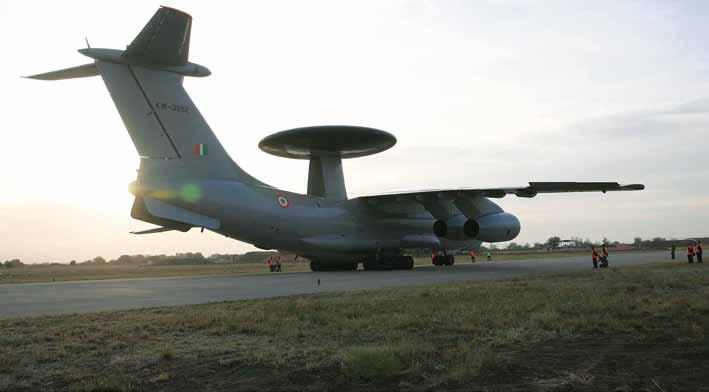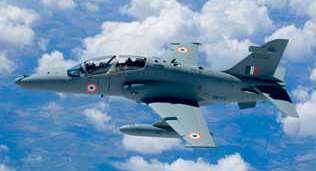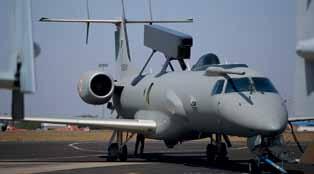
5 minute read
Air Defence
aWaCS ControlS an aIr battle WIth the enveloPe extendIng over 200 km Into enemy terrItory
CONCEPT OF INTEGRATED AIR DEFENCE COMMAND
The proposed “Air Defence Command” is a retrograde step and if allowed, would become the biggest strategic military blunder for the Indian Armed Forces
By Group Captain C.J. Weir (retd)
Soon after taking over in January 2020 as the first Chief of Defence Staff (CDS), under directions from the government, General Bipin Rawat initiated the process of creation of an integrated military command that would take charge of air defence operations of the Indian military. The proposal seeks to take away the critical “Air Defence” role from the Indian Air Force (IAF) and create a separate “Air Defence Command”. This issue needs to be examined from the prism of national interest and cannot be clouded by interservice rivalry and misplaced military ego.
THE CONCEPT
The Air Defence Command would be a stand-alone arm of Indian air power whose aim would be to protect vital areas and vital points (V/A’s/VP’s) of the nation from enemy aircraft. The system would bring under one umbrella all the components of the air defence machinery. The four components of the system would continue to be detection, identification, interception and destruction. The current assets of the IAF namely aircraft, systems and manpower, would be amputated from the main body to create the new Air Defence Command. This reminds one of the air defence organisation set up of the 70’s and 80’s. What has changed since then is the dramatic enhancement of capability in each of these four areas that comprise an air defence network.
Strategic Shift. These well orchestrated changes brought about by the planners capitalised on acquiring more capability, third and fourth generation technology in aircraft so that the multi-role employment could be contemplated. More importantly, the change in the planning of an air battle occurred was made possible by the acquisition of Airborne Warning and Control System (AWACS) aircraft and the in-flight refueller. Today, India has a very potent Air Force having evolved over the years of its existence. Having so evolved, the proposed “Air Defence Command” is not how a potent air power machine, like what India has, should be employed. Let us, dispassionately, examine whether a stand-alone air defence system is more suited to the Indian context or an offensive/defensive philosophy which revolves around destruction of enemy aircraft and other military targets before they are allowed to bear down on our VA’s/VP’s. The system so suggested, must be most suited to war scenarios and also cater to peacetime threats.
NUANCES OF AIR DEFENCE OPERATIONS
Whilst analysing both the systems, we must avoid the temptation of templating different global scenarios and shoe-horning them to the Indian context. Our situation is, that there is a near parity in capability on our Northern and Western flanks. We, therefore, may never have the luxury of “Air Supremacy” or even “Air Superiority” initially. A hard fought “Favourable Air Situation” in the early phases of the war, is the most likely condition
that will exist. As the war progresses beyond three to five days, the Indian Air Power would be able to create the higher levels of dominance where the destructive capability of Indian air power can be unleashed to destroy the enemy’s war-waging potential. Therefore, a defensive strategy of “let him come and I will stop him” is far less likely to succeed than a strategy of offensive/ defence where his aircraft are destroyed as early as possible.
EVOLUTION OF THE OFFENSIVE / DEFENSIVE STRATEGY
The first hurdle that any military air power planner faces, is to keep pace with the rapidity that each of the four air defence components change. Military aviators find that they have to continuously keep updating their arsenals of knowledge to understand and capitalise on the unimaginable technological leaps in capability that take place. The sensors are now airborne, the weapon platforms have multiple role capability, the offensive/defensive divide had first blurred and now does not exist. Besides, the sensors and weapon platforms can now be tasked for both roles in the same mission. Understanding each of these separately, requires effort, putting it all together to form a potent force takes generations of military aviators putting their heads together, depending on years of actually operating the sensors and weapon platforms and bringing it all to fruition in what is loosely termed as “The Indian Air War Machine”.
The Air Battle. This requires some elaboration. India has over the last 30 years developed its air power potential with the acquisition of the AWACS and in-flight refueling platforms as well as air dominance combat aircraft. This combination is lethal and has permitted the IAF to be able to become truly offensive. The

philosophy of engagement of an enemy target itself has changed. The command and decision-to-destroy loop now permits real time allocation of targets to our aircraft which are already airborne and can stay on station for long durations. The philosophy of dynamic targeting has evolved. The point at which a potential threat could be destroyed has shifted farther and farther away from our own VA’s/VP’s. The AWACS controls an air battle with the envelope extending over 200 km into enemy territory and down to surface levels. This gives us the ability to destroy enemy aircraft as close to the launch bases as possible, it also permits the same aircraft to carry out attacks against runways, bridges and concentration of enemy surface forces. The battle commander chooses the target which has the highest threat priority. Thirty years ago, these would be four different missions with no guidance across the border and additionally another lot of aeroplanes would be solely devoted to Classic Air Defence which depends on a multi-tiered engagement philosophy because the threat in the form of a high speed low flying aircraft is very potent. Preventing such a lethal intruder from delivering a weapon has to be achieved by an early detection and identification process followed by achieving multiple engagement solutions by aircraft and surface weapons. The engagements must culminate in a weapon solution which results in the destruction of the intruding enemy. Coordinating the airborne and surface weapons is a massive task achieved by putting systems in place and then practicing near real time solutions. This was thirty years ago!! Today the strategy is of an offensive/defensive air battle and this is planned and executed by one agency to achieve destruction of the enemy aircraft, optimisation of resources and avoidance of fratricide. Our capability now permits us to shift the entire air battle














